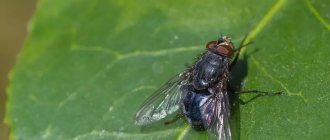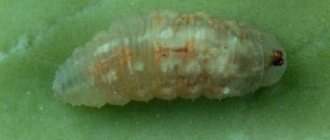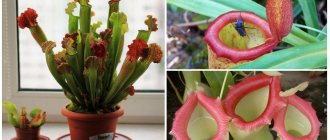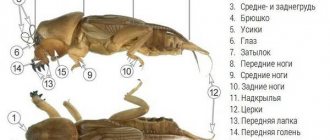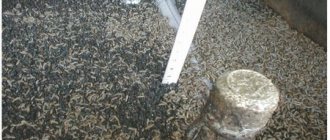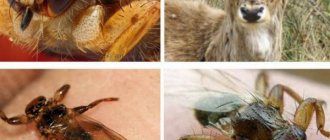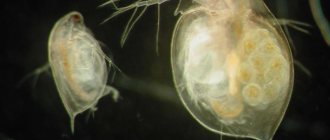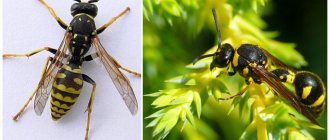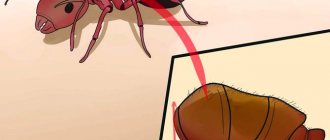Appearance of blow flies
The large family includes 106 genera, 3 subfamilies. Externally they differ in size and color. Corpse flies that live on our territory are practically no different in appearance from indoor and household pests.
- Body length from 5 to 25 mm. The average size of a blowfly is 20 mm.
- The color is gray with stripes, a checkerboard pattern, and black spots. Or shiny with tints of blue, green, yellow. Glistens beautifully in the sun.
- The eyes are large and bright red.
- The wings are transparent, slightly set aside.
A photo of a blowfly is shown below. The most common types in our area are gray, blue, and green.
On a note!
The larvae of meat scavengers come in two types: smooth and hairy. They have the shape of a worm, about 15 mm in length. The smooth “cubs” feed on the juices of corpse meat, the hairy ones are predators, eat the first ones, and always appear on the corpse a little later.
Viviparous flies give birth to miniature white larvae - maggots. Other species of this family lay eggs. Round, yellowish in color, no more than 1 mm in size. They are located in groups. The worms go through three molts and gradually increase in size. At the last stage, the worms burrow into the soil, pupate, and emerge as adults. The entire development cycle from egg to adult takes 11 days under favorable conditions.
The most common varieties
Gray
It has a large body 10–14 mm in length, with red eyes on its white-yellow head.
The head is divided in half by a black stripe; on the chest there are light stripes located longitudinally. The segmented abdomen of the gray blowfly has an oblong shape, the legs are very densely covered with short hairs.
Blue
The body reaches a length of 10–16 mm, has a blue color with a faint light coating.
The head is yellowish-red, shimmering with a golden sheen.
There are dark whiskers on the cheeks.
The breast is black with a bluish tint.
On the back are faint longitudinal black stripes.
Distributed in all forest regions of Russia.
Green
The body size is 5–10 mm in length.
The body color is green with a metallic sheen.
The abdomen has a faint coating of light shades.
The wings are transparent, the tentacles are yellowish, and the legs are black.
This species is very thermophilic and is found in central Russia only in hot summers.
It mainly lives in semi-desert, desert and steppe areas.
Habitat
Gray blowflies are distributed throughout the world, but their largest populations are found in the European part of Russia, the Caucasus, Central Asia and Siberia.
Blowflies can be found anywhere where they can gain access to quickly decomposing organic matter: in garbage dumps, in country and street toilets, in markets with open food storage, especially in meat aisles. Also, flies do not bypass hospitals in places of military operations.
When flying in search of a suitable place, flies on average can travel up to ten kilometers in their lives.
Reproduction
Females of gray blowflies are viviparous, which gives them an undoubted competitive advantage over other species. Flies lay larvae on meat, fish, waste, rotting fruit, in a word, on any decaying organic matter, including wounds on living creatures, which after the appearance of the larvae turn into ulcers.
It is enough for the female to touch the selected place with her abdomen for a moment for the larvae to be born and immediately begin to crawl and bite into the meat.
The place of penetration of the larvae is easy to track, since under the influence of the juice produced by the larvae, the meat begins to quickly decompose, releasing liquid and disintegrating.
The larvae feed on this “broth” and particles of meat, as they prefer an already digested product.
The larvae do not neglect living creatures either, eating the insides of grasshopper larvae, beetles, snails and caterpillars.
After feeding for five days, the larvae move underground and pupate, falling into a long hibernation, sometimes lasting for months. Sometimes the pupae even overwinter, and the hatched flies emerge from the ground only in early spring.
It is interesting how adult flies come to the surface, since the body structure of an adult is not designed for digging. But gray flies have found an interesting way: between their eyes they have a frontal bubble, which, when inflated, increases several times and pushes the ground.
Adult blow flies, which live only a week, spend most of their time on flowers, pollinating them, and looking for a place to lay the larvae of future offspring.
How do larvae eat?
The larva cannot yet bite off pieces of solid food. How does she eat? During the research, an experiment was carried out: pieces of slightly dried meat were placed in two flasks, and green fly larvae were planted on one of them. After a few days, the piece of meat on which the larvae lived became so soft that it resembled more of a liquid pulp. At the same time, the piece of meat in the second flask did not change at all. That is, the larvae, secreting a special secretion from their mouths, liquefy solid food, turning it into a kind of broth, and then feed on this broth.
It turns out that they digest food before eating it. In addition, the hook-shaped projections on the head of the larva are also involved in the process of such digestion. As the larva digs its hooks into the flesh, it secretes digestive juices. It is absorbed into the meat in the places where the hooks were attached.
Having reached a certain age, the larva burrows into the ground, where it pupates. After a while, the cocoon lid bursts, and a young green fly appears from under the ground. After drying the wings a little in the sun, she rushes off in search of rotting flesh.
Harm
Now let's talk about the harm a blowfly can cause to humans. In addition to the fact that they are unpleasant when they appear near a home, they are also capable of carrying diseases dangerous to humans. The most terrible of them is leprosy, or leprosy. But this, of course, is very rare in our time, but an upset gastrointestinal tract will not give us pleasant sensations.
In addition, blowflies can lay larvae on fresh and even lightly salted foods. Thus, the blowfly harms the same fishermen who hang out not completely salted fish for drying.
Flies also annoy our pets. They also carry their diseases by feeding on the corpses of dead animals.
Breeding
For those who are not against breeding blow flies, and in particular their maggot larvae, this section of our story is intended. We will tell you how to make the simplest maggot from our favorite material for all kinds of crafts - an indispensable plastic bottle.
This is done as follows:
- Cut the plastic bottle into two parts so that the upper part with the neck, being turned over and inserted into the lower half, does not reach the bottom by 4-5 centimeters.
- Pour sawdust into the lower part of the “one and a half” or “kopeck piece” in a layer of two to three centimeters.
- Place a piece of fresh or spoiled meat or a piece of fish in the upper part. By the way, you can also add a few small fish that you discarded after fishing.
- Place the maggot in a shaded area.
When the meat begins to spoil, the flies will smell it and lay eggs there. The hatched larvae will feed on the substrate offered to them. Soon, a week after their eggs hatch, they will stop feeding in preparation for pupation, and will leak through the neck of the bottle straight into the sawdust.
Thanks to crawling in sawdust, maggots will be cleared of the smell of carrion, and you can take them with you fishing without hesitation. If you put an egg in a maggot, the larvae will be the largest.
Typically, people don't think about how many species of flies there are. Most of us only notice differences in color and size, not realizing that some types of flies can be beneficial. The blowfly is quite large and has a bright color. The development of its larvae occurs in fish and meat products, as well as in animal corpses.
Gray blowfly
This fly is also called a sarcophagus. She is carrion. This is a large fly, its length reaches 25 millimeters. Gray blowflies are, as the name implies, gray in color with a darker checkered or line pattern, with a yellowish-white head “divided” by a black stripe. The eyes are red, and there are white longitudinal lines on the belly. The body shape is oblong, the abdomen is covered with large bristles, and the legs are shaggy.
Gray blowflies are rare guests in a human home and appear there only if they have something to profit from there. The sense of smell of these flies is very developed, and they are able to smell the smell of rotting meat at a very long distance. Moreover, they only need to touch the surface of the meat for many small worms to immediately begin to move on it.
Female gray blowflies are viviparous and lay their larvae primarily in carrion. But there are representatives of this family, the larva of which is capable of developing in rotting fruit, feces or other decomposing organic matter. There are also types of flies whose larvae are capable of parasitizing other living organisms.
The larva of this fly is characterized by extraintestinal digestion. Sometimes she is able to feed on the larvae of other insects or practice cannibalism. The blowfly larva lives on carrion for up to 10 days, after which it moves into the soil, where it turns into a pupa, and then into an adult fly.
The pupa of a blowfly can hibernate; for example, the pupae of some species of sarcophagus are able to “sleep” through the entire winter and turn into an adult only in late spring.
The blowfly feeds on the nectar of flowers, and at the same time pollinates them, carrying pollen on its shaggy legs.
The attitude towards gray blowflies, as well as other carrion species, cannot be unambiguous. Being carriers of infectious diseases, they also serve as a kind of orderlies in nature. And forensic criminologists are able to determine the time of death by the age of the larvae in a decomposing corpse.
Biology of hoverflies
The hoverfly insect family belongs to the order Diptera, unlike wasps and bees, which have two pairs of transparent wings. They are distributed throughout the globe and are found in almost all places except the desert and tundra; in Russia alone there are more than eight hundred species.
The color of insects of this family is black and yellow with slight variations observed in all species. Imago, adult hoverflies feed on pollen and nectar of plants, but the larvae of hoverflies have a wider palette of tastes.
Development
Adult insects appear in the garden in late spring. Mating of hoverflies occurs in mid-summer, and their active years last until early August. Each female is capable of laying up to two hundred white eggs. She places them on grass, plant stems, directly in the soil, and on tree branches.
Larva
All fishermen and their wives are well aware of the larva of the blowfly - maggot. The hoverfly larva is the same maggot, only slightly smaller in size, only a centimeter long.
The larvae feed depending on the species:
- predators - aphids and psyllids;
- herbivores - bulbs;
- aquatic - detritus;
- woody - dead plant tissue, including manure.
Hoverflies, due to the peculiarities of their evolution and similarity with wasps, have spread over most of the globe. They are found everywhere except hot deserts, tundras and, of course, Antarctica. Entomologists count about 6 thousand species of these insects, of which more than 1.5 thousand are found in the Palearctic, 800 in Russia, and 2 species were found even in the subarctic zone.
Although the bee fly is similar to wasps and bees, it is absolutely harmless. Below are the signs by which the hoverfly can be distinguished from dangerous insects:
- Syrphid flies are dipterous insects, so the presence of only one pair of wings is the first difference from bees, which have four wings.
- The fly's wings are larger and wider.
- The ability to “hover” in the air and suddenly change direction of flight. This happens thanks to the halteres - a reduced pair of wings.
- A fly has thinner limbs than a bee, and plant pollen does not accumulate on them.
- There are no hard hairs on the body of the hoverfly, but there is fine fluff, like a bumblebee.
- Wasps are non-social insects. Individual individuals live on their own and group only during the mating period.
At the end of June, after wintering, an adult wasp fly emerges from the pupa. After mating, females lay eggs and continue to fly until the end of July. Insect eggs develop in the soil near lily and umbrella plants or on the branches of bushes and trees.
Nutrition
The diet of adult hoverflies, like bees, consists of flower nectar and pollen. Therefore, insects can be found near the flowers of fruit trees, berry bushes and in the garden near umbrella plants.
The larvae, depending on the species, differ in the way they feed. Among them there are vegetarians, predators and saprophages that eat decaying remains. Adherents of plant foods gnaw the stems and bulbs of lilies. Aquatic types of flies dive to the bottom of reservoirs and eat the dendrite. Some exotic representatives of hoverflies will not refuse to feast on dung and decaying wood, while others live in symbiosis with ants, feeding on their reserves.
Predatory larvae are the worst enemies of spider mites, aphids and other small insects, eating not only adults, but also their eggs. It is interesting to watch the larvae hunt for aphids. The leech-like larva crawls along the stems, and when it finds an aphid, it stops and raises the front part of its body (like a snake), swings and attacks its prey.
Green blowfly
This is a beautiful fly of a glossy emerald color with smoky wings that have a faint openwork pattern. The length of the green fly usually does not exceed 8 mm. It has large reddish eyes, a rounded belly and white cheeks.
The habitat of the green blowfly is places of all kinds of sewage, decomposing animal corpses, manure, waste, but sometimes they are also found in flowering plants that have a strong aroma. The food consists of rotting organic matter, where it lays its eggs.
One female is capable of laying approximately 180 grayish or light yellow eggs, which she tries to hide in carrion as deep as possible. The larvae are born after 6-48 hours and continue to develop there for another 9 days. They then move into the soil to develop into a pupa. Depending on weather conditions, an adult fly is formed within 10-17 days.
Blue carrion fly
Calliphora vicina also has other names:
- red-headed blue carrion;
- blue blowfly;
- red-headed;
- red headed blue fly.
This species was once very important in medieval healing. Today, the method of cleansing wounds using maggots is again gaining popularity. In modern medicine, blue blowfly maggots are also used to sterilize wounds and prevent necrosis. But now they are grown in sterile conditions.
Body length 5-14 mm. The dark blue belly is covered with bristles. The female lays up to 300 eggs and is capable of producing 5 generations during her life. Offspring are laid on fresh corpses or open wounds. The development cycle at 27°C takes 18 days.
How dangerous are gray blowflies?
Since the main habitats of blow flies are garbage dumps and other places with decaying garbage, it is not surprising that these insects are carriers of a whole type of disease, ranging from gastrointestinal disorders to typhoid fever and cholera .
The larvae are dangerous because when they get on the mucous membranes and wounds of humans and domestic animals, they contribute to the development of ulcers and provoke blood poisoning.
Larva
The larva of the gray blowfly reaches 2-3 millimeters. It differs from most larvae of other species in that its rear part is equipped with a respiratory recess in the form of a cup with special valve plates.
This extravagant arrangement of the spiracles provides the larva with the opportunity to dive into liquids and grab onto meat with its mouth hooks, without fear of suffocation, since the back part is exposed to the air. An interesting effect can be observed from the accumulation of many feeding larvae: their exposed and moving spiracles resemble sea anemones.
Similarities and differences
Both families of dipterans belong to corpse flies. But if meat products only cause harm to a living person, then carrion maggots are used to clean wound surfaces from dead tissue.
There are more similarities between the families than you might think:
- some species can reproduce in both meat and feces;
- some species switched to parasitizing living mammals (Wolfartova in Europe and Lucilia cuprina in Australia parasitize sheep);
- Adults feed on flower nectar.
Also, the larvae of flies on meat can belong to species from both families.
Protection measures
The most successful in getting rid of flies can be considered those activities that are aimed at cleaning standard insect habitats:
- continuous removal and destruction of waste on an industrial scale;
- neutralization of liquid waste in sewerage basins or cesspools;
- maintaining cleanliness in places where meat and fish products are sold;
- timely removal of household waste;
- destruction of larvae and pupae with chemicals in suspicious places;
- installation of mosquito nets on windows;
- washing hands before eating.
Struggle
Controlling blowflies is not difficult and, if basic hygiene rules are followed, may not be necessary at all. You just have to follow the basic rules:
- Do not create a landfill near your home, throwing meat and fish waste there.
- When animals or birds die or are slaughtered, it is imperative to bury their remains under a layer of soil and not allow them to decompose in the open air.
- In the summer, install nets on the windows to prevent blow flies and other insects from entering the premises. This especially applies to people living on the lower floors of apartment buildings or in low-rise buildings.
- Hanging sticky traps can also significantly reduce blowfly numbers.
- A room heavily infested with flies can be treated with some insecticidal agent, for example, the popular Dichlorvos.

